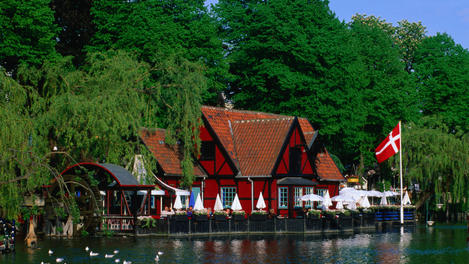
View gallery
1. Feast on gourmet cuisine in Copenhagen
A few years ago, the laid-back city of Copenhagen wouldn’t have been top of many lists for fine dining. Today, it has more Michelin stars than any other Scandinavian city. Chef René Redzepi uses only Scandinavian produce such as musk ox and local lobster at Michelin-starred Noma. But for all the fuss about the ‘New Danish revolution’, Copenhagen can still charm with its traditional food – can there be a better meal than an open sandwich of pickled herrings or a plate of meatballs at a canal-side cafe?Recommended hotel: 71 Nyhavn, housed in a 2000-year-old warehouse
2. Catch and cook your own lobster in Sweden
The Bohuslän coast is one of Sweden‘s natural treasures, and in the clear waters offshore lurks a culinary treasure – the mighty lobster. From late September to December you can devote a weekend to a lobster safari at local hotel Handelsman Flink. For £300, you set out to sea to catch the lobster, get a cooking course in the hotel restaurant and enjoy the result in a three-course meal.Recommended hotel: Handelsman Flink, featuring 10 rooms and two suites with sea views
3. Book a ham, cheese and wine trail in Northern Italy
The food in the region of Emilia-Romagna in northern Italy is all about ham, cheese, red meat and wine – and lots of it. Take one of several food and wine trails from Parma and you’ll get to meet local producers of prosciutto, Parmigiano reggiano, balsamic vinegar, Parma wine, black truffles and porcini mushrooms. Back in Parma, head to the Salumeria Verdi delicatessen for produce to take home.Recommended hotel: The Leoni, an agriturismo a couple of miles from Parma
4. Tour Somerset’s cider-apple orchards
Get a refreshing taste of pretty Somerset by hitting the Vintage Cider Trail, an independent walk organised by Foot Trails, an award-winning rural walking company. With a personalised itinerary and map in hand, amble through orchards of apple trees, pop into a pub for a pint and stop at cider farms to speak to scrumpy makers, safe in the knowledge that a good meal and a night in a pre-booked inn awaits.5. Help out at a vineyard in Portugal’s Upper Douro
Awarded World Heritage status in 2001, the Upper Douro valley produces some of Portugal‘s best wine. The family-run Quinta Nova winery and guesthouse is set up so you need not set foot outside ti to gain a proper understanding of the whites, reds and port produced here, while having a damn fine weekend at the same time. Take one of the trails form the estate and you’ll find yourself traversing vineyards, helping with farming activities or learning to make olive oil at the olive press.
Recommended hotel: Quinta Nova, decorated in rustic Portuguese style
6. Whisky galore in Scotland
The families who own the Monachyle Mhor Hotel and the Glengoyne whisky distillery have joined forces to create the Whisky, Food and Mhor package: two nights in one of the beautifully decorated rooms at Mhor, with a dinner of locally sourced produce, followed by a trip to Glengoyne for a distillery tour and the chance to blend your own malt.Recommended hotel: Monachyle Mhor, right on Loch Voll
7. Sample the Lake District’s local produce
The English Lake District is fast becoming a hotbed of culinary creativity, with a focus on local produce and modern British cooking. There’s no finer spot to experience the renaissance than the Brown Horse Inn, a bar, restaurant and guesthouse in the Winster valley that sources all its produces from a three-mile radius, and much of it from its own farm estate. The nearby village of Staveley has some of the Lakes’ best food outlets, including the Hawkshead Brewery, Lakes Speciality Foods deli and Lucy Cooks cookery school.Recommended hotel: The Brown Horse Inn, gourmet central
8. Lose a few days in France’s Champagne region
Leave the planning (and the driving) to the experts by booking a weekend Champagne tour with Grape Escapes, a specialist wine tour operator that runs five different itineraries to the region. In addition to visiting wine makers and sampling local produce, you can attempt the age-old art of sabrage (removing the cork from a bottle using a cavalry sword.)9. Stay with a local producer in southern Italy
Foresteria di San Leo, a former 13th-century Benedictine monastery with views towards the Lucan Dolomites, has been restored by husband and wife Maria and Peppino, who use all the ingredients from their land to cook the dishes served in the 16th-century former storehouses. Chatty Maria is such an enthusiastic cook that even if you can’t speak Italian, she’ll get you whipping up pasta and sauces as if it was your calling. Enjoy homemade cakes for breakfast, pick your own salads for lunch, and tuck into buffalo mozzarella, burrata, pasta and lamb cutlets in the evening.
Recommended hotel: Foresteria di San Leo has five simple rooms and two apartments with kitchens
10. Visit the brandy vineyards of Cognac, France
Lying in the Charente valley in southwestern France is Le Logis du Paradis guesthouse, an 18th-century farmhouse that makes a perfect base for exploring the Cognac houses for which the area is known worldwide. Most of the bigger distilleries (Camus, Hennessey, Martell and Rémy Martin among them) are in the unassuming town of Cognac itself; smaller producers can be found down the country lanes that weave through the surrounding vine-covered hills. The owners of Le Logis can arrange tours, tastings and the chance to buy the world’s finest brandy at cellar-door prices.Recommended hotel: Le Logis du Paradis has five beautifully renovated, beamed rooms
Get more tasty recommendations from the monthly Lonely Planet Magazine.










































